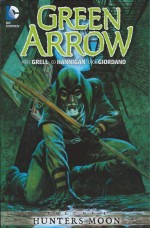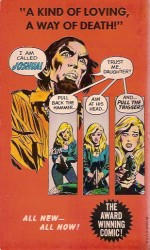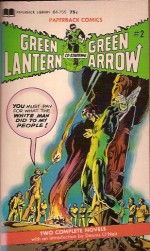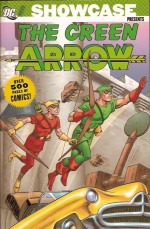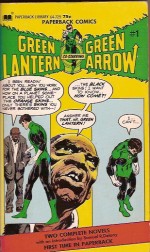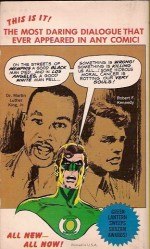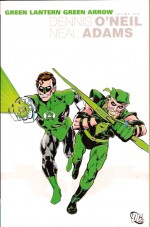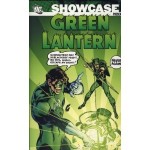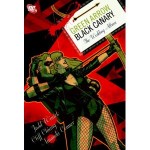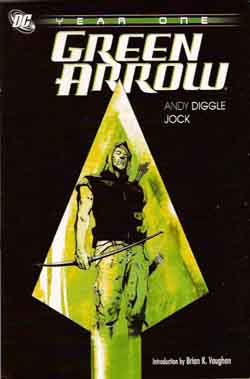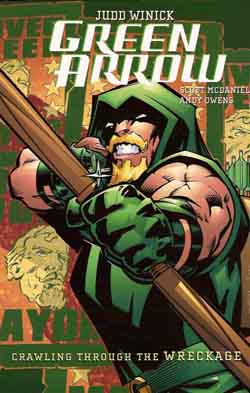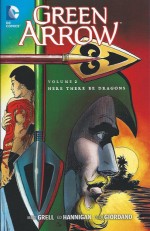
By Mike Grell, Ed Hannigan, Dick Giordano & various (DC Comics) ISBN: 978-1-4012-4326-5
Premiering in More Fun Comics #73 in 1941, Green Arrow is one of very few superheroes to be continuously published (more or less) since the Golden Age of American comicbooks. At first glance this blatant amalgamation of Batman and Robin Hood seems to have very little going for him but he has always managed to keep himself in vogue.
Probably his most telling of many makeovers came in 1987, when, hot on the heels of The Dark Knight Returns, writer/artist Mike Grell was tasked with making him the star of DC’s second “Prestige Format Mini-Seriesâ€.
Grell was one of comics’ biggest guns at the time. Beginning his rise with a laudable run on Legion of Super-Heroes, he went on to draw the revived Green Lantern/Green Arrow and practically saved the company with his Edgar Rice Burroughs-inspired fantasy epic Warlord. He had also notched up a big fan following illustrating many Aquaman, Batman and Phantom Stranger stories before establishing his independent creator credentials at First Comics with Starslayer and Jon Sable, Freelance…
In the grim’n’gritty late Eighties, it was certainly time for another overhaul of the Emerald Archer. Exploding arrows yes, maybe even net or rope arrows, but arrows with boxing gloves or paint brushes on them just wouldn’t wash with a newer, more sophisticated readership. Thus, in an era of corrupt government, drug cartels and serial killers, the evergreen survivor adapted and thrived under the direction of a creator famed for the uncompromising realism of his work.
The Longbow Hunters focused on the superhero’s mid-life crisis as he relocated to Seattle and struggled to come to terms with the fact that since his former sidekick Speedy was now a dad, Oliver Queen had technically become a grandfather. Beside long-time “significant other†Dinah Lance – AKA Black Canary – he began to simplify his life, but the drive to fight injustice never dimmed for either of them.
Dinah went undercover to stamp out a drug ring whilst Ollie became engrossed in the hunt for a psycho-killer dubbed “The Seattle Slasherâ€. The archer also learned of a second – cross-country – slayer who had been murdering people with arrows…
Eschewing gaudy costume and gimmicks, Queen reinvented himself as an urban hunter to stop such unglamorous, everyday monsters, stumbling into a mystery which led back to World War II involving the Yakuza, CIA, corporate America and even the Viet Nam war, even as it introduced a deadly female counterpart to the beleaguered bowman: an enigmatic, morally ambiguous archer called Shado…
The intricate plot, subtly blending three seemingly separate stories which were in fact one, still delivers a shocking punch even now in its disturbingly explicit examination of torture: a treatment which won the series undeserved negative press when it was first published. Although possibly tame to most modern tastes, this was eye-opening stuff in the 1980’s, which is a shame, as it diverted attention from the real issue… and that was a massive surge in quality and maturity.
The intricate, maturely sophisticated plot – interweaving themes of age, diminishing potency, vengeance and family – were another turning point in American comics and led to an ongoing series specifically targeting “Mature Readersâ€. The treatment and tone heavily influenced and flavoured today’s TV adaptation Arrow and has led to the release of Grell’s nigh-forgotten urban predator tales in a new range of economical, no-nonsense, full-colour trade paperbacks.
This second collection, primarily scripted by Grell with superbly efficient and powerfully understated art from Ed Hannigan, Dick Giordano & Frank McLaughlin plus a few guest creators, re-presents Green Arrow volume 2, #7-12 (eccentrically cover-dated August through December plus “Winter†1988), offering starkly authentic tales ripped from headlines that have as much impact and relevance today as they did nearly thirty years ago…
Sparse, Spartan and startlingly compelling, the drama begins – sans any preamble – with complex collaboration ‘The Powderhorn Trail’, written by Grell and Sharon Wright – who divided the Ollie and Dinah sections between them – with Randy DuBurque illustrating Black Canary portions whilst Ed Barreto pencilled the GA bits, after which Giordano & Arne Starr inked it all.
The round-robin episode sees the hunter (the series was notable in that other than on the cover, the soubriquet “Green Arrow†was never, ever used) stumbling upon a clue to drug-smuggling at his local carwash and having to explain to Dinah why he’s taking off for Alaska, even as she is approached by a casual acquaintance whose life she once saved, who inadvertently tips the Canary to a string of crimes-in-the-making…
The all-action conclusion (by Grell, Paris Cullins, Gary Martin & Giordano) then sees Ollie solo-stalking from Anchorage to deep in the North country on the trail of not just drug dealers and high-end car thieves but also opportunistic Tong smugglers trafficking illegal, poached and pointless Chinese herbal remedies under cover of the infamous Iditarod…
The remainder of this book deals with the eagerly-anticipated return of Shado in the 4-part ‘Here There Be Dragons’ (Grell, Hannigan, Giordano & Frank McLaughlin) which opens with the reunited Ollie and Dinah celebrating a birthday whilst still attempting to reconcile the changes in their life. As much as the after-effects of being brutally tortured still affect her, they trouble him far more…
Killing her tormentor haunts them both, as does the role the enigmatic Japanese archer played in the bloody drama. With the memories still poisoning the atmosphere, neither hero is particularly happy when sleazy CIA executive Greg Osborne comes back into their lives with another offer they’d better not refuse.
Far across the Pacific, Shado has fallen out of favour with the Yakuza masters who took a little girl and turned her over decades into a living weapon. When one arrogant young Oyabun overstepped his authority he turned her into an implacable foe of the entire organisation. Now to save face the criminal society must kill her at all costs…
In Seattle, Osborne blackmails Ollie, forcing him to go to the Philippines in search of the country’s gold reserves which have been hidden since the Japanese occupation in WWII. The current US administration wants to help its Eastern ally without being seen to be interfering, especially since a treasure map has surfaced and the Yakuza are using it to murderously appropriate the lost bullion.
The Japanese gangsters are simultaneously searching the islands for a mysterious dragon-tattooed woman archer who apparently has somehow won possession of the gold chart…
Dinah is unconvinced by Ollie’s reasons for going. She knows he is fascinated to the point of obsession with the exotic archer, but still stands aside as the hunter embarks for Hawaii. All too soon Queen’s specialised knowledge has put him on Shado’s trail, but that only makes him a perfect target…
A few weeks later, Ollie is slowly recovering from an arrow in the chest, nursed back to health from the edge of death by the beguiling tattooed woman; seduced as much by her arcane philosophy of archery as her beauty, compassion and air of fragility. In the quiet hours they grow closer and she shares her tragic origins with him, as well as the recent events which made her both free agent and fleeing fugitive.
Faced with the choice of defying Osborne or reluctantly handing her over to the American authorities pressurising him, Ollie is forced into a third option when Yakuza death-squads attack their isolated island retreat, prompting a prolonged chase through the region and a bloody trail impossible to cover-up…
The harassed quarry eventually double-back to Honolulu for a climactic final battle during which Ollie discovers how the Yakuza have been able to dog their steps so closely. He and Shado part for what he secretly prays is the last time, after which, armed with suspicions of exactly who Osborne is actually working for, Oliver confronts his blackmailer…
Terse scripts, intelligent, flawed human interactions, stunning action delivered through economical and immensely effective illustration and an unfailing eye for engaging controversy make these epic yarns some of the most powerful sagas American comics ever produced. Compiled here with a cover gallery by Grell (both fully painted and line art), Joe Rubinstein, Hannigan & Giordano, this compulsive retooling is yet another long-overlooked highpoint of superhero storytelling no lover of the genre will want to miss.
© 1988, 2014 DC Comics. All Rights Reserved.

